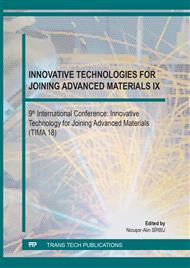p.16
p.21
p.27
p.36
p.46
p.52
p.58
p.64
p.78
Research on Metallurgic Active Precursors
Abstract:
The paper presents the current state of researches carried out in order to improve homogeneity of mixtures for metallic powders; our priority is those with different participation in the mixture, by mechanical alloying. Mixtures of this type are used in the production of welding and related materials.Recently, research has been done to improve deposited metal properties by welding with coated electrodes, by depositing nanostructures, with uncertain results due to the low degree of homogeneity of blends involved in the electrode coating.The performance enhancement method for coated rods, developed by introducing in their coat activating precursors, used for brazing, is well known. The solution to improve the degree of homogeneity of alloying systems by mechanical alloying has been successfully applied for the manufacture of coated electrodes and those tubular with a composite core which are deposited by manual welding or TIG welding, type Fe25% Cr-4% W-V-Ti-La. The grouping of powder components for mechanical alloying was done in such a way that, finally, we have groups with the granulation, respectively specific weight, close and a low potential of segregation.The method of mechanical alloying of the components was used in the manufacture of coated rods in order to improve the fluidity of silver-rich buffer layers deposited in order to favor the diffusion phenomena of brazing alloys in the base materials.Testing the homogeneity of the alloying systems was performed indirectly by metallographic analysis and sclerometric tests.
Info:
Periodical:
Pages:
46-51
Citation:
Online since:
May 2019
Keywords:
Price:
Сopyright:
© 2019 Trans Tech Publications Ltd. All Rights Reserved
Share:
Citation:


